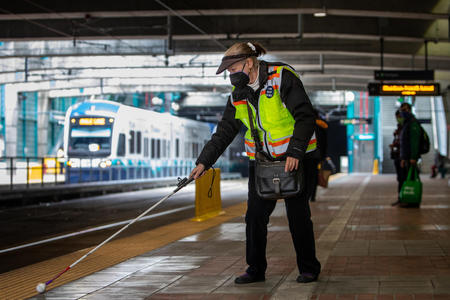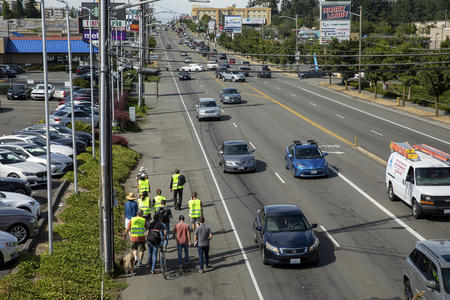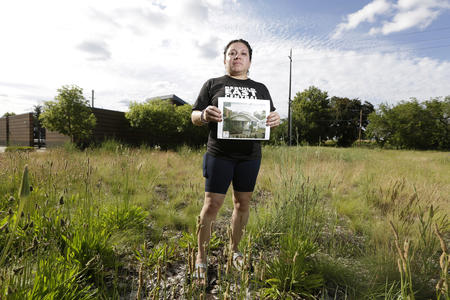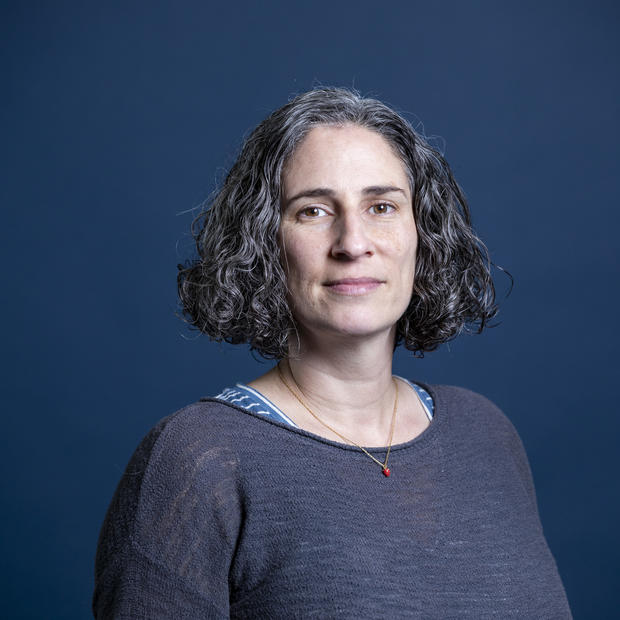More and more drivers are fleeing fatal and serious collisions, and it’s pedestrians and bikers, and their families, who are bearing the brunt of this deadly upward trend occurring across the state and country.
“I would have been so ready to start the forgiveness process, but this person wouldn’t take responsibility. And it’s really hard to get to that place when you don’t know who it is,” Mason said. “You don’t know if they have any sense of remorse.”
Claudia Mason lost her husband Robb in a hit-and-run near the Spokane Street Bridge when he was commuting home on his bike from West Seattle. Mason remembers her husband as a confident, loving and curious man. To help identify the driver, Mason went public with her grief, talking with the media to appeal to the driver’s sense of humanity, or to their family or friends. Seattle Police Department later identified and found the driver, who was charged with vehicular homicide and felony hit-and-run. (Amanda Snyder/Crosscut)
It infuriates Mason how much her life has changed since her husband’s death. She now comes home to an empty house, eats alone.
“Once the fog started to clear and I realized I have to make a new routine out of pretty much everything I do,” Mason said. “I used to get up really early and walk to the pool for extra exercise and now it’s too depressing. So I sleep more.”
The couple lived in Magnolia, and Robb commuted several days a week by bike or scooter to West Seattle to a physical therapy clinic — a job he’d held for a decade and half. He tried to avoid using the Spokane Street Bridge, Mason said, which despite having a separate lane for people walking and rolling sometimes puts bikers uncomfortably close to heavy traffic, especially at intersections. But the day he died he took the bridge to save time.
So many drivers just don’t care, Mason said.
“No one should take their last breath like that,” she said. “This guy stole so much more than he can ever imagine when he was so reckless.”
Mason described Robb as a renaissance man, interested in all things. Then she quickly rattled off a list: kind, caring, compassionate, considerate, charismatic, confident and courageous.
Letters poured in from friends and strangers after Robb died.
“It’s just heartbreaking,” said Mason, her voice breaking slightly, “so many people who were so touched by him in their lives.”
Using several private and public security cameras in the area, including one mounted on a bus, the Seattle Police Department identified the make and model of the car involved in the collision early on. But Mason feared officers wouldn’t get the evidence they needed to prove who was driving, and that person would go free.
To find the driver, Mason felt she had to go public with her grief, talking with the media to appeal to the driver’s sense of humanity, or to their family or friends. And writing an op-ed for The Seattle Times.
“It made it so much harder for me to just grieve in my own private way,” said Mason.
Due to distinctive damage done to the driver’s car prior to the July collision, officers tracked and located the vehicle to an address in southwest Seattle, according to police reports. Through phone records, the officers determined that the owner, Mohamed Yusuf, had been driving at the time of the crash.
The 20-year-old was charged with vehicular homicide and felony hit-and-run on Dec. 27, 2022. He’s due back in court on April 20 for a routine pretrial hearing. His lawyer declined to comment.
That is not the conclusion of many hit-and-run cases.
As many U.S. cities are becoming more dangerous for pedestrians and cyclists, transportation leaders are turning attention to this increasing phenomenon. While fatal hit-and-runs are a small portion of this deadly trend, it is often one that is overlooked. In an attempt to fill that gap, Crosscut took a deep dive into the data and spoke with law enforcement, city officials and traffic safety researchers about what they think should be done.
“It’s heartbreaking. It’s infuriating,” said Councilmember Tammy Morales, who represents Seattle’s South End, where a disproportionate number of pedestrian and biker deaths occur and where Robb Mason was killed. “I don’t understand how somebody could leave and not render aid.”
Fleeing the scene
The number of deadly collisions on Washington’s roads have actually trended downward over the past three decades — except for a particularly deadly 2021 and 2022. Hit-and-runs resulting in fatalities and serious injuries, though, have been moving in the opposite direction over that time period, according to data from the state’s Traffic Safety Commission.
This uptick in fatal hit-and-runs began as far back as 1994, followed by a steeper incline starting in 2007. Nationwide, too, deadly hit-and-runs have been increasing over the past decade, data from the National Highway Traffic Safety Administration shows. (Without complete data for 2022, researchers are uncertain how the new driving patterns that emerged during the pandemic have impacted these crashes.)
In Seattle, the average number of fatal hit-and-runs since 2016 has jumped from about one or two a year to eight.
On average, over the past four years in Seattle, drivers fled the scene in two of every five fatal pedestrian and bike collisions, the city’s Department of Transportation data shows. That’s higher than the most recent state and nationwide collision data shows, where about one in five deadly crashes involving a pedestrian or biker is a hit-and-run.
Overall it’s hard to tell if hit-and-runs in general, fatal or not, are increasing. They are difficult to track. Many go unreported, especially those not resulting in a serious injury or death. And with little research into why these crashes happen, it’s also hard to pinpoint why the numbers are climbing. And without a witness, it can be challenging to obtain reliable information on exactly why drivers flee.
State law requires drivers to stop and remain at the scene if they are involved in a crash that results in injury, death or damage. They must render aid or call for help. Hit-and-run laws were enacted in Washington as early as 1937.
One witness to a fatal hit-and-run on a wet October night last fall told police they heard a thud, then saw a person lying in the street, not far from the Mt. Baker light-rail station in south Seattle just before 8 p.m..
But without functioning streetlights along that stretch of Rainier Avenue, the witness didn’t get a good look at the fleeing vehicle, according to the police report. The city’s Traffic Collision Investigation Squad was left with very little information to find the driver.
On Vashon Island over the summer, a hit-and-run left a man dead less than a block from his house. He was found near the side of the road by deputies hours after being reported missing, according to media and police reports. A suspect was later arrested.
A person waits at a bus stop on the corner of Rainier Avenue South and South Walden Street on Tuesday, March 14, 2023. A woman was killed in a hit-and-run at this spot last October. A witness said no streetlights were working, and thus was unable to get a description of the vehicle that drove off. (Amanda Snyder/Crosscut)
Reasons why
“I think they mostly happen because the pedestrian is the only witness,” said Staci Hoff, research director for the Washington Traffic Safety Commission. “A lot of the pedestrian and biker hit-and-runs happen at night, and so there literally is nobody else around.”
Experts, from law enforcement to safety groups, list impairment, fear of going to jail, immigration status and concerns over losing vehicle insurance or being subjected to increased rates as reasons they’ve heard from drivers explaining why they have left crash scenes.
Reflecting on fatal hit-and-run case reviews she has done, Hoff believes a main motivator for leaving the scene of a crash is because a driver had been consuming alcohol or drugs.
“They see an easy getaway,” she said.
William Horrey, a researcher at the AAA Foundation for Traffic Safety, says fleeing a collision is often an act of self-preservation. The nonprofit supports research into traffic safety, driver behavior and how emerging technologies impact driving. With a background in engineering psychology, Horrey studies how people interact with technology and the world around them.
“It’s fear of recrimination for another crime. Whether it’s intoxicated driving or substance impairment,” Horrey said, “driving without a valid license, and so on.”
Studying hit-and-runs is inherently really difficult, he acknowledged. “Absent the driver and hearing from them, it’s really difficult to know for certain.”
“A lot of the time, we’re actually just looking at data and trying to make inferences from that,” he added, “but not with the benefit of being able to actually interact with any of the individuals involved.”
All this makes a hit-and-run a hard crime to investigate. And they often go unpunished.
Going unpunished
In Kennewick, drivers have fed Sergeant Matt Newton all kinds of excuses for fleeing a collision.
With a population of 84,500, Kennewick is the largest of the Tri-Cities that hug the Columbia River as it turns east. Each year the city in south-central Washington sees few deadly hit-and-runs but plenty, between 300 and 500, of non-fatal ones.
“I’ve had people say ‘I had to go to the bathroom,’” said Newton, who heads the city’s traffic department and is an officer liaison on the Cooper Jones Active Transportation Safety Council’s fatality case review team. “You're kidding me. Right? You crashed into another car. You hurt somebody but you had to go to the bathroom.”
He has also had drivers tell him they thought there wasn’t enough damage to make it a crime. Or that they panicked.
“They would rather gamble on the fact of leaving the scene, rather than staying and filing a claim and getting the insurance company involved,” added Newton.
It’s a wager that often works in the fleeing driver’s favor, with only 20% of hit-and-run drivers ultimately caught in the past two years in Kennewick, according to Newton: “It just shows you how difficult a crime it is to investigate.”
The Seattle Police Department did not reply to a request for numbers of fatal hit-and-runs that have been solved over the past two years in the city. The department also declined to make an officer from the Traffic Collision Investigation Squad available for an interview.
“A hit-and-run is harder to solve than a collision where all parties remain on scene,” said Detective Valerie Carson, a department spokesperson, in an email. “One of the hardest parts of solving a hit-and-run collision is proving who was driving the suspect vehicle at the time of the crime – it’s often easier to find/identify the vehicle, but can be very difficult to gather evidence proving who was driving it.”
With police departments facing a nationwide staffing shortage, Newton said his traffic enforcement team is less than half staffed as the city shifts officers to patrol units.
“We still focus on collisions, but we’re much more reactive right now,” he said – as opposed to being able to send officers out on the road proactively looking for drivers talking on cell phones, speeding or committing other infractions. But even with a fully staffed team, Newton doesn’t think hit-and-runs would decrease.
Researchers and police and transportation departments, meanwhile, aren’t making progress in reducing hit-and-runs because they are often left with little information about why the driver fled, which also makes it hard to pinpoint why the numbers have gone up.
Curbing hit-and-runs
Since launching its Vision Zero initiative in 2015 with the goal of eliminating traffic fatalities and serious injuries, the City of Seattle has struggled to reduce the number of people dying on city streets. In fact, the numbers have actually gone up. Between 2019 and 2022, the city averaged more than 27 deaths a year, with a large percentage being people outside of vehicles — an uptick from previous years. King County, Bellevue and the state have also all adopted the goal of eliminating traffic deaths and serious injuries.
Greg Spotts, director of Seattle’s Department of Transportation, vowed to make traffic safety a top priority, promising a top-to-bottom review of the city’s Vision Zero efforts when he took over the agency last fall. That report, months overdue when it was released in late February, made several recommendations including reducing vehicle speeds to improve safety. But Seattle’s Vision Zero report doesn't specifically call out hit-and-runs.
“The main focus of what our Vision Zero effort is looking at is what can be done from a road engineering perspective,” said Ethan Bergerson, a spokesperson for SDOT. “It’s hard to get inside the mind of people. And so it’s not something that we’re not interested in, but it’s just a harder thing to tackle than going out and looking at how the road is designed.”
Digging deeper into why a hit-and-run might occur is not necessarily an area of focus for our team, added Allison Schwartz, a member of the department’s Vision Zero team.
City Councilmember Tammy Morales has spent her four years on the council calling for improving and adding sidewalks and installing more protected bike lanes in her district, which two of the deadliest roads run through.
Morales sees an expanded role for traffic enforcement cameras by adding more ways to ticket drivers committing traffic violations. She recognizes there are legitimate concerns, particularly in the South End and in communities of color, about being overly surveilled. Still, she believes something must be done.
“If you’re gonna blow through a red light and injure or kill somebody and keep driving, that’s not OK,” she said. “These are your neighbors that you’re injuring or killing. We need to do something to slow people down to demand that people pay attention to safety.”
In Kent, Sergeant Jason Bishop sees a link between the staffing crunch and the increased number of traffic crimes and infractions, including hit-and-runs, he’s observed during his time as head of the city’s traffic division.
“Enforcement is what ends up taking the brunt of it,” said Bishop. “And if there’s no enforcement, then when the cat’s away the mice will play.”
To help find or at least track fleeing drivers, Bishop wants to see traffic enforcement camera video become available to officers.
“Right now, we’re really limited as to what we can do with speed cameras and red-light cameras,” Bishop said. “If one of them captures a hit-and-run, we’re actually not allowed to use that video for the crime of hit-and-run.” State law prohibits footage from being used in court for violations other than the ones the camera is tracking.
Barb Chamberlain thinks tougher penalties might stop drivers from fleeing collisions. Chamberlain is director of WSDOT’s Active Transportation Division and a member of the Cooper Jones Active Transportation Safety Council, named in honor of a Spokane teenager who was killed while riding his bike.
“If you want to get away with murder, use a vehicle, which is sort of a facetious statement, but at the same time, our penalties for what happens if you seriously injure or kill somebody with a car are less than so many other things,” Chamberlain said. “I would have more consequences for using a baseball bat than to do what a car does to somebody.”
But that must be balanced with the recognition that fines and penalties will affect poor people disproportionately, Chamberlain said: “Hammers hit some people harder than others.”
Sentences for hit-and-runs vary depending on many factors including past convictions, according to Casey McNerthney, spokesperson for the King County Prosecuting Attorney's Office.
For someone with no previous felony history, general sentencing guidelines set by state lawmakers for a hit-and-run that results in a death is 31-41 months. That’s lower than the guidelines for a conviction of manslaughter in the first degree or a vehicular homicide in which the driver was under the influence of alcohol or drugs or driving in a reckless manner, both which carry a 78-102 month sentence, according to McNerthney.
A cultural shift in regard to traffic safety is also needed, Chamberlain added, along with changing road design to separate bike and pedestrian paths to remove the possibility of vehicles hitting people walking or rolling.
“Are you paying attention to other people, not just yourself?” she said. “What do we say about what matters — is what matters is getting someplace faster? What matters is not killing people.”
This session, the Washington State Legislature has considered a suite of transportation bills aimed at making Washington roads safer, including banning right turns on red lights in areas with lots of pedestrians and bikers, dropping the blood-alcohol limit, and requiring people 25 or younger to complete a driver’s education class before getting a license. None of these proposals directly address hit-and-runs. Only the bill expanding driver’s education requirements remains alive in the Legislature halfway through the session.
Claudia Mason has used her platform to urge drivers to slow down and to advocate for safer streets for people walking and rolling. She’s all too familiar with what it’s like to be struck by a fleeing driver while on a bike: She was knocked unconscious outside Nordstrom in downtown Seattle a few years ago. As her senses returned, she woke up surrounded by concerned passersby who had called 911 to get help and report the fleeing car.
“It’s kind of normal. It’s really sad, but it’s pathetic. But somehow the cars seemed to think that it’s OK,” Mason said. “Especially if they didn’t kill you.”
















